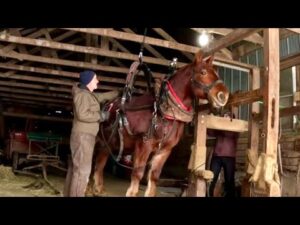
Working with draft horses is rewarding but physically demanding, and if you have a bad shoulder, harnessing them can be a real challenge. Whether you’re dealing with chronic pain, an old injury, or temporary weakness, finding ways to make harnessing easier is crucial for both you and your horses. Here are some strategies to help you get the job done with less strain on your injured shoulder.
1. Modify Your Approach
One of the biggest hurdles when harnessing draft horses is lifting and positioning the harness. Traditional harnesses can be heavy, so modifying your technique can reduce strain. Instead of lifting the harness all at once, break the process into smaller steps:
- Rest the harness on a rolling stand at about waist height to reduce lifting strain.
- Use a step stool to lessen the distance you have to raise the harness.
- Lift with your legs, not your arms, and shift weight evenly to avoid overloading the bad shoulder.
2. Use a Pulley System
If lifting the harness onto the horse’s back is the hardest part, consider installing a simple pulley system in your barn. A pulley or winch can help hoist the harness, allowing you to position it without excessive lifting. Simply attach the harness to the pulley, lift it to the appropriate height, and then guide it onto the horse’s back.
3. Adjust Your Equipment
Harness weight can vary, and switching to a lighter harness or a synthetic version can make a significant difference. Leather harnesses, while traditional, are heavier than modern synthetic options, which can be just as strong and durable. Additionally, padded collars and ergonomic design modifications can reduce strain on both you and the horse.
4. Enlist Help
There’s no shame in asking for assistance. If you work with others, have someone help with lifting and positioning the harness. If you’re alone, train your horses to stand near a fence or platform so you can use an elevated surface to assist with lifting.
5. Train Your Horses for Cooperation
A well-trained draft horse can make harnessing much easier. Teach your horses to lower their heads and stand quietly while being harnessed. Some horses can even be trained to lean slightly to allow easier harness placement. The less resistance you have from the horse, the easier the job will be on your bad shoulder.
6. Use Adaptive Tools
There are several adaptive tools available to help make harnessing easier:
- Harness caddies that allow you to roll the harness to the horse.
- Modified snaps and clips that require less force to fasten.
- Quick-release buckles to eliminate excessive pulling.
7. Listen to Your Body
Pushing through pain can make the problem worse. If harnessing becomes too difficult, take breaks and use alternative methods. Ice, heat therapy, and stretching exercises can also help manage shoulder pain and keep you in working condition.
Conclusion
Harnessing draft horses with a bad shoulder requires adjustments in technique, equipment, and mindset. By modifying your approach, using assistive tools, and seeking help when needed, you can continue to work with your horses without worsening your injury. With the right strategies, you’ll be able to harness your drafts efficiently and comfortably, ensuring both your safety and theirs.